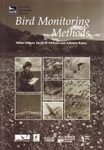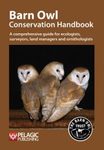About this book
Concentrations of Palaearctic passerines were discovered at the lights of Ngulia Lodge, Tsavo West National Park, Kenya, in December 1969. It was established that such ‘falls’ of southbound migrants occurred regularly each November and December when there was low mist or rain at night under moonless conditions. They involved three main species, Marsh Warbler Acrocephalus palustris, Thrush Nightingale Luscinia luscinia and Common Whitethroat Sylvia communis, as well as several other migrants little known west of the Kenya highlands, but included surprisingly few Afrotropical birds. Thousands of migrants were often grounded at night, but these moved on within one day. Such concentrations were rare in spring because of a lack of night mist, but a few April falls revealed a very different species composition.
From 1972 to 1992 migrants were ringed by small teams each year over November-December new moon periods. Birds were trapped at dawn in mist-nets set in bush south of the Lodge and, from 1976, in one to three nets set below the floodlights at night. In more recent years larger teams have been involved. Dawn operations were moved in 1994 to an area north of the Lodge, beyond the floodlights, resulting in larger catches, often of well over 1 000 birds. Experiment at night with playback of recorded song showed some species to be responsive when already brought low by lights and cloud, but overflying migrants did not react and come to ground on clear nights.
In autumn (late October to early January) the Lodge has been manned on well over 1 100 nights, with mist occurring on over 60% of these and rain on 26%. The incidence of these attractive conditions has been higher later in the season. A total of 499 677 Palaearctic birds ringed to 2012 has given 222 long-distance ringing movements. These comprise 122 to or from Palaearctic breeding areas, 81 to or from Middle East passage sites, 18 from southern African wintering areas and one from a likely Ethiopian stopover area. Only 63 birds ringed have been retrapped at the Lodge in a subsequent season. Catches have involved a mix of first-year and adult birds, in most species in a ratio of about two to one. Racial plumage characters and winglengths indicate that most species are from populations breeding in eastern Europe or western / central Asia. Each species has a characteristic seasonality at Ngulia. Marsh Warbler passage picks up only in mid November but continues into January, whereas that of Thrush Nightingale begins earlier but declines in mid December. Species occurring early, mainly in November, include Red-backed Shrike Lanius collurio, Olive-tree Warbler Hippolais olivetorum, Rufous Scrub Robin Cercotrichas galactotes, Spotted Flycatcher Muscicapa striata and Eurasian Nightjar Caprimulgus europaeus.
Patterns of moult are summarized. Some species reach Ngulia with newish looking flight feathers grown the previous July–August, some with very new feathers grown in northeast Africa in October–November, and some with old worn feathers due for renewal in southern Africa in January–March. Details of weights are discussed. Some species are frequently 20-30% and sometimes 50% above lean weight, with a potential for long onward flights. These include Marsh Warbler, Common Whitethroat, River Warbler Locustella fluviatilis, Willow Warbler Phylloscopus trochilus, Basra Reed Warbler Acrocephalus griseldis, Olive-tree Warbler and Red-backed Shrike. By contrast, others such as Irania Irania gutturalis, Olivaceous Warbler Iduna pallida, Rufous Scrub Robin, Upcher's Warbler Hippolais languida and Isabelline Shrike Lanius isabellinus are rarely 20% above lean weight; none of these migrate far south of Ngulia. Species tend to show a small mean weight increase between early November and December. There are significant changes in mean weight from year to year, often by over 5%, suggesting different feeding possibilities and migration strategies. Traces of the annual mean weight of Marsh Warbler and River Warbler correspond closely. At night, weights are lowest between 03:00 and 06:00, then increase during the day to a late afternoon peak 8-10% above the late night minimum. Birds caught after heavy rain tend to have higher weights than those on nights of typical mist. Comparison of the composition of catches over four decades shows a recent increase in the percentage of Marsh Warbler and a decrease in Common Whitethroat. Isabelline Shrike and Rufous Scrub Robin feature much less in catches than formerly, and trends would also suggest a recent decrease in Upcher's Warbler and Willow Warbler.
Major outstanding questions concern the location of the autumn stopover areas of the birds which subsequently arrive at Ngulia, and the events by which these are brought down to the lights in such numbers from overhead passage.
Contents
Summary 1
Introduction 2
History and review of operations
The earlier years (1969-1992) 3
More recent years (1993-2012) 7
Update of autumn ringing data
Coverage, numbers ringed and recovered 11
Recoveries, origins and races of individual Palaearctic species 14
Diurnal changes in species pattern 19
Seasonal timing of migration 20
Age proportions 23
Patterns of wing moult 25
Weights and fat loads 27
Long-term trends 32
Discussion
Migration strategy and stopover questions 34
Questions regarding attraction to the lights 35
Potential role of Ngulia in population monitoring 36
Acknowledgements 37
References 37
Recovery maps 40
Appendices 44
Photographic section 69
Customer Reviews






















![Ageing & Sexing of Migratory East Asian Passerines [English / Chinese]](http://mediacdn.nhbs.com/jackets/jackets_resizer_medium/25/250760.jpg?height=150&width=115)




